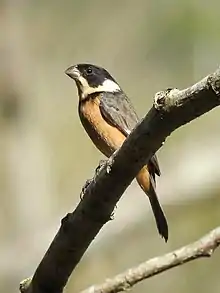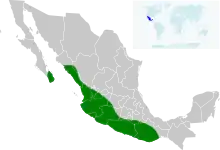Cinnamon-rumped seedeater
The cinnamon-rumped seedeater (Sporophila torqueola) is a passerine bird in the typical seedeater genus Sporophila.
| Cinnamon-rumped seedeater | |
|---|---|
 | |
| Scientific classification | |
| Kingdom: | Animalia |
| Phylum: | Chordata |
| Class: | Aves |
| Order: | Passeriformes |
| Family: | Thraupidae |
| Genus: | Sporophila |
| Species: | S. torqueola |
| Binomial name | |
| Sporophila torqueola (Bonaparte, 1850) | |
 | |
Taxonomy
This species is one of two resulting from the split of the former white-collared seedeater. The other former white-collared seedeater subspecies are now known as Morelet's seedeater. Genetic studies show that the cinnamon-rumped seedeater is more closely related to other Sporophila seedeaters than it is to Morelet's seedeater.[2] There are two subspecies:
- S. t. torqueola is found in southern Baja California and western Mexico.[3]
- S. t. atriceps is found in central and southwestern Mexico.[3]
Distribution and habitat
The cinnamon-rumped seedeater is endemic to western Mexico. It mainly inhabits tropical and subtropical grasslands, savannas, and shrublands but can also be found in pastures, arable land, and heavily degraded former forests.[1]
Foraging
The cinnamon-rumped seedeater eats mainly seeds and insects, and occasionally berries. It forages often top of herbaceous plants, and less often on the ground.
References
- BirdLife International. 2017. Sporophila torqueola (amended version of 2016 assessment). The IUCN Red List of Threatened Species 2017: e.T103816948A119484178. https://dx.doi.org/10.2305/IUCN.UK.2017-3.RLTS.T103816948A119484178.en. Downloaded on 29 June 2018.
- Mason, Nicholas A.; Olvera‐Vital, Arturo; Lovette, Irby J. & Navarro‐Sigüenza, Adolfo G. (February 2018). "Hidden endemism, deep polyphyly, and repeated dispersal across the Isthmus of Tehuantepec: Diversification of the White‐collared Seedeater complex (Thraupidae: Sporophila torqueola". Ecology and Evolution. 8 (3): 1867–1881.
- Gill, Frank; Donsker, David; Rasmussen, Pamela (eds.). "Tanagers and allies". IOC World Bird List. International Ornithological Congress. Retrieved 28 November 2020.
Further reading
- Skutch, Alexander F. (1954). "White-collared seedeater" (PDF). Life Histories of Central American Birds. Pacific Coast Avifauna, Number 31. Berkeley, California: Cooper Ornithological Society. pp. 33–37.
